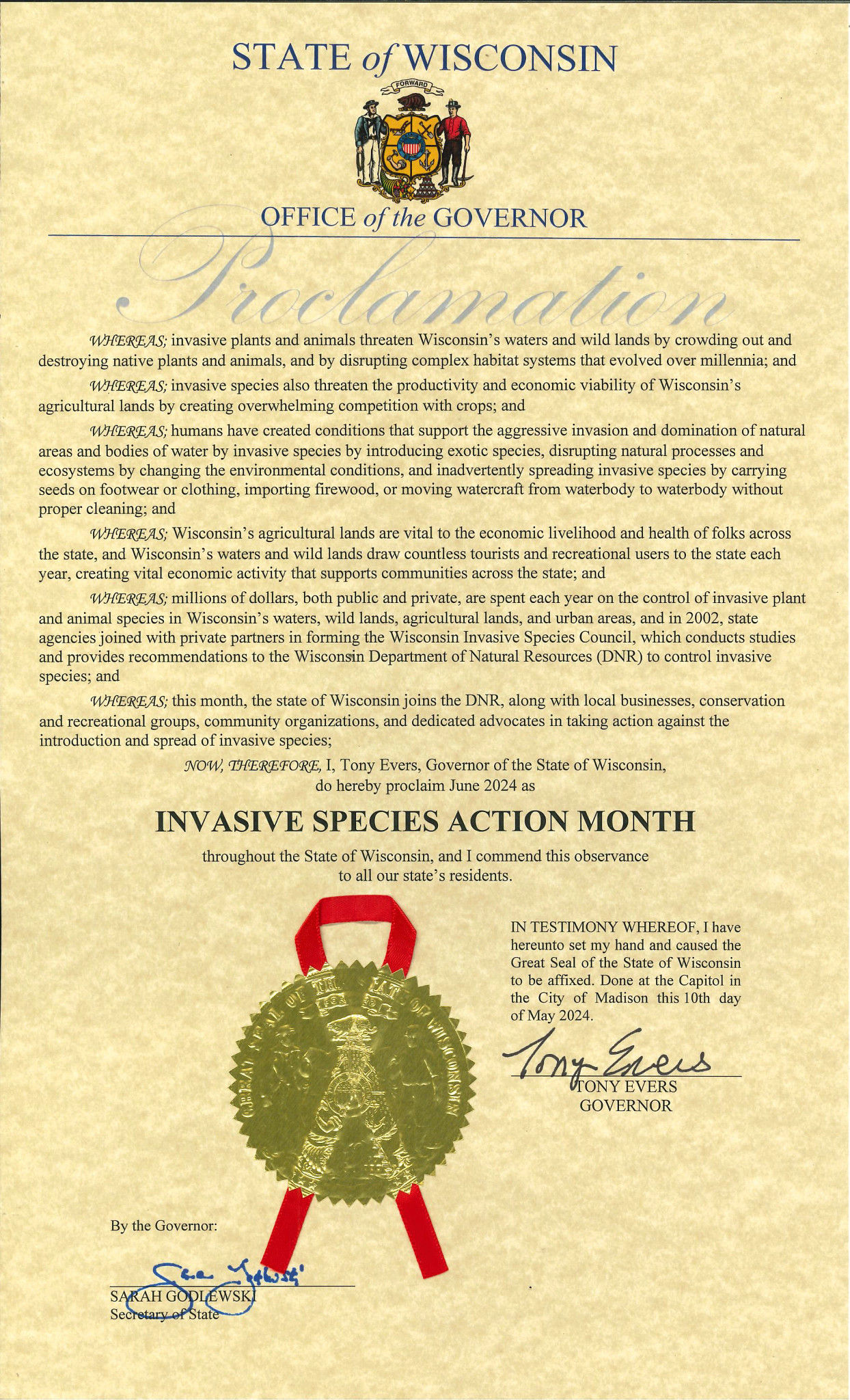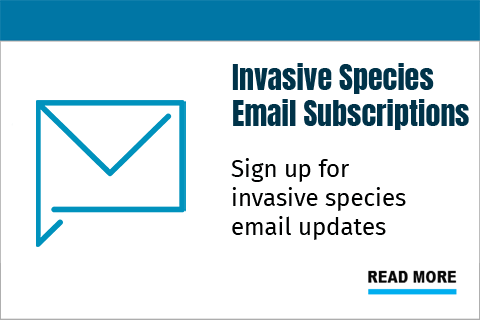Wisconsin Invasive Species Council
The council hosted online information sessions to present recommended changes to the classification of invasive species in Wisconsin's Invasive Species Rule – ch. NR 40. Learn more about the response and next steps.
Governor Tony Evers proclaims June as Invasive Species Action Month in Wisconsin. Check out the Council's Initiatives and Events tab to learn how you can get involved and read about recipients of the annual Invasive Species Action Awards.
In 2002, state agencies joined with private partners to form the Wisconsin Invasive Species Council as directed by s. 23.22, Wisconsin Statutes.
Council Duties
The council makes recommendations to the department regarding the following:
- a system for classifying invasive species and
- a procedure for awarding cost-sharing grants to control invasive species.
The council also conducts studies of issues related to controlling invasive species. Wisconsin law requires the council to address the following:
- the effect of the state's bait industry on the introduction and spread of invasive species;
- the effect of the state's pet industry on the introduction and spread of invasive species;
- the acquisition of invasive species through mail order and Internet sales; and
- other issues as determined by the council.
The council relies on four committees to carry out its work: education, research, regulation and interagency coordination. An executive committee provides overall direction for the council's activities.
2024 Information Sessions
The council is responsible for making recommendations to the department regarding classifying invasive species in Wisconsin's Invasive Species Rule – ch. NR 40. To accomplish this, the council convenes Species Assessment Groups to review and assess species and make recommendations for which species should be included in NR 40.
The council hosted online information sessions to present Species Assessment Group recommendations to the public and to gather feedback on proposed regulatory classifications. Watch recordings of the February and March 2024 information sessions or learn more about Species Assessment Groups and the revision process.
A message from the Wisconsin Invasive Species Council (May 2024):
“Thank you to all who took the time to provide feedback on the council’s recommendations. We greatly appreciate the effort and thought that went into each comment. We received 35 separate contacts from the public, including survey responses, emails and phone calls.
We are reviewing the information you provided and considering how it may impact recommendations. It will take time to thoughtfully assess each comment and discuss it. Any revisions to recommendations will be announced on the council web page, and an email will be sent to everyone who responded to our call for public input and registered for each session. Questions for the council can be sent to Mackenzie Manicki at Mackenzie.Manicki@wisconsin.gov.
Once finalized, regulatory recommendations will be sent to the DNR, which will begin the rule-making process. During this process, additional opportunities for public input will occur.
Council Members, Committees, Initiatives and Resources
- Council Members And Contact Information
-
Members Representing Public And Private Interests
Members Organization Contact Information Thomas Bressner Wisconsin Agri-Business Association 608-444-1420 (c)
608-223-1111 (w)
Tom@wiagribusiness.orgThomas Buechel (Chair) Buechel Horticulture Solutions, LLC 920-650-6808 (c)
Buechel.iscouncil@gmail.comDouglas Cox Menominee Indian Tribe of Wisconsin 715-853-8053
dgcox@mitw.orgJennifer Hauxwell, Ph.D University of Wisconsin Aquatic Sciences Center 608-263-4756
Fax: 608-262-0591
Jennifer.Hauxwell@aqua.wisc.edu
http://aqua.wisc.eduGregory Long Needles and Leaves Nursery 262-679-1011 (w)
262-617-3284 (c)
GLong@NeedlesAndLeavesNursery.comMark Renz University of Wisconsin-Madison Department of Agronomy 608-263-7437
MRenz@wisc.eduHannah Spaul The Nature Conservancy 608-316-6441 (w)
HSpaul@tnc.orgMembers Representing State Agencies
Members Agency Contact Information Drew Feldkirchner Department of Natural Resources (DNR) 608-267-5129 (desk)
Drew.Feldkirchner@wisconsin.govVacant Department of Tourism Vacant Rebecca Szymkowski Department of Transportation (DOT) 608-266-9381 (desk)
Rebecca.Szymkowski@dot.wi.govBrian Kuhn Department of Agriculture, Trade and Consumer Protection (DATCP) 608-224-4590 (desk)
Brian.Kuhn@wisconsin.govLauren Leckwee Department of Administration (DOA) 608-267-2125 (desk)
Lauren.Leckwee@wisconsin.govTara Bergeson Department of Natural Resources, Natural Heritage Conservation 608-438-2872 (c)
Tara.Bergeson@wisconsin.gov - Council Initiatives And Events
-
Strategic Plan
"Looking Forward: A Statewide Strategic Plan for Invasive Species" was finalized on April 2, 2013. The plan outlines a framework of objectives to minimize invasive species' environmental and financial harm and protect human health and natural resources. This plan identifies needs that must be met cooperatively across agencies and jurisdictions. It develops cost-effective, balanced approaches to minimize invasive species' introduction into Wisconsin and carefully manage the species already established in the state.
Species Assessment Groups
The council convenes Species Assessment Groups to review and assess species and recommend which should be included in Wisconsin's Invasive Species Rule, ch. NR 40. Specifically, Species Assessment Groups recommend a regulatory (Prohibited, Restricted) or non-regulated category to the council for each considered species.
Invasive Species Action Awards
Each year, the council honors Wisconsin citizens and organizations for their significant contributions to preventing, controlling or eradicating invasive species that harm Wisconsin's lands, waters and wetlands. 2024 marks the 20th anniversary of the Invasive Species Action Awards (previously known as the Invader Crusader Awards). Check out this year's recipients.
Award Recipients From The Last 20 Years - What Are They Up To Now?
Action Month

Governor Tony Evers proclaims June as Invasive Species Action Month, a time to learn about, identify, report and control invasive species in Wisconsin. Check out the DNR’s events calendar to find events in your area!
Wisconsin Natural Resources Magazine articles celebrating Invasive Species Action Month efforts:
- Stalking Invasive Species
- Cooperative Endeavors Spell Success
- Look For and Report These Nine Invasive Species
Check out some of the award-winning Invasive Species Action Month video challenge winners:
- "Boatbusters!" by Brad Steckart and the Washington and Waukesha County AIS Teams
- "Freeing the Old Oak" by Charlie Luthin and Sauk Prairie Conservation Alliance
- "CBCW Vice" by Chris Hamerla and his dog Cisco
- “AIS Monster” by David Blumer
- Council Committees
-
Committees
Education Committee
- Charge: Seek ways to enhance outreach and education efforts to raise statewide awareness of the identification and prevention of invasive species.
- Chair: Christa Schaefer – Wisconsin Department of Transportation
Executive Committee
- Charge: Develop the council's meeting agendas and respond to time-sensitive issues.
- Chair: Thomas Buechel – Buechel Horticulture Solutions, LLC
Interagency Committee
- Charge: Promote coordination among state agencies on invasive species issues and issues related to developing and implementing Wisconsin's Invasive Species Rule.
- Chair: Brian Kuhn – Wisconsin Department of Agriculture, Trade and Consumer Protection
Regulations Committee
- Charge: Focus on current and future rules, statutes and administrative policies to prevent the spread of and control invasive species. Make recommendations to the council to take the appropriate steps to promote uniform and consistent state regulations and policies to curtail the introduction and movement of invasive species for the protection of the environment, agriculture and human health for generations to come.
- Chair: Gregory Long – Needles and Leaves Nursery
Research Committee
- Charge: Convey the current knowledge base to the council as a whole; assemble and evaluate research; provide a pool of experts for communication; identify areas where the existing knowledge base is inadequate; solicit community on research needs; research components including invasive impacts, control, basic biology, avenues of introduction and prioritization of research needs.
- Chair: Vacant
- Meeting Minutes
-
View and download council and committee meeting minutes:
2023
- Aug. 24
- Aug. 9 - Executive Committee
- June 7
- May 17
- May 3 - Executive Committee
- Feb. 8
- Jan. 25 - Executive Committee
2022
- Sept. 29
- June 30
- June 22 - Executive Committee
2021
- Oct. 19
- Sept. 7 - Executive Committee
- June 10
- May 6
- Feb. 4
- Partners, Grants and Local Ordinance Links
-
Partners
The council partners with several Cooperative Invasive Species Management Areas across the state to manage invasive species. Cooperative Invasive Species Management Areas are local organizations that bring together landowners and land managers to coordinate action and share resources in the fight against invasive species. Each Cooperative Invasive Species Management Area has a defined geographical area distinguished by a common invasive species problem. Learn more about Cooperative Invasive Species Management Areas.
The council also partners with the Wisconsin Aquatic Invasive Species Partnership, which includes professionals from the department, the Lakes Monitoring and Protection Network, UW-Madison Extension and UW-Stevens Point Extension Lakes. Partners engage in various activities, including Aquatic Invasive Species education and outreach, citizen monitoring, providing Aquatic Invasive Species funding and more.
Financial Assistance
- Wisconsin DNR Grants
- U.S. Dept. of Agriculture Invasive Species Grants
- U.S. Forest Service Forest Health Protection Grants
- U.S. Environmental Protection Agency – Great Lakes Initiative
- National Fish and Wildlife Agency
- Grant.gov
- Natural Resources Foundation of Wisconsin
Local Ordinances
Chapter 66, Wisconsin Statutes, establishes the state's general municipal law. Among other regulatory authorities, local units of government, town chairs, village presidents, city mayors, and managers can annually require the destruction of all noxious weeds within their respective municipalities. The statute defines "noxious weed" as "Canada thistle, leafy spurge, field bindweed, any weed designated as a noxious weed by the Department of Natural Resources by rule, and any other weed the governing body of any municipality or the county board of any county by ordinance or resolution declares to be noxious within its respective boundaries" (s. 66.0407(1)(b), Wis. Stats.). The law requires that landowners destroy all noxious weeds on lands they own or control. Below is a list of some example ordinances adopted by Wisconsin municipalities. The Wisconsin Invasive Species Council recommends that local noxious weed ordinances be used to facilitate the implementation of ch. NR 40, Wis. Adm. Code, and that when designating noxious weeds, emphasis should be placed on regulated invasive species as listed in NR 40. Below is a list of local ordinances regarding invasive species control around the state. To find local ordinances regarding invasive species control around the state, visit Wisconsin State Library - local ordinances and codes.
Chapters 59, 60, and 61, Wis. Stats., authorize expenditures for the control of invasive species, weeds, and pests. Wisconsin Statutes also permit municipalities to impose special charges against property for current public services provided to the property, including noxious weed cutting/removal. The League of Wisconsin Municipalities has prepared a manual that outlines the procedures prescribed by Wisconsin law for levying special assessments. The Legislature's website has a template for local noxious weed ordinances.

